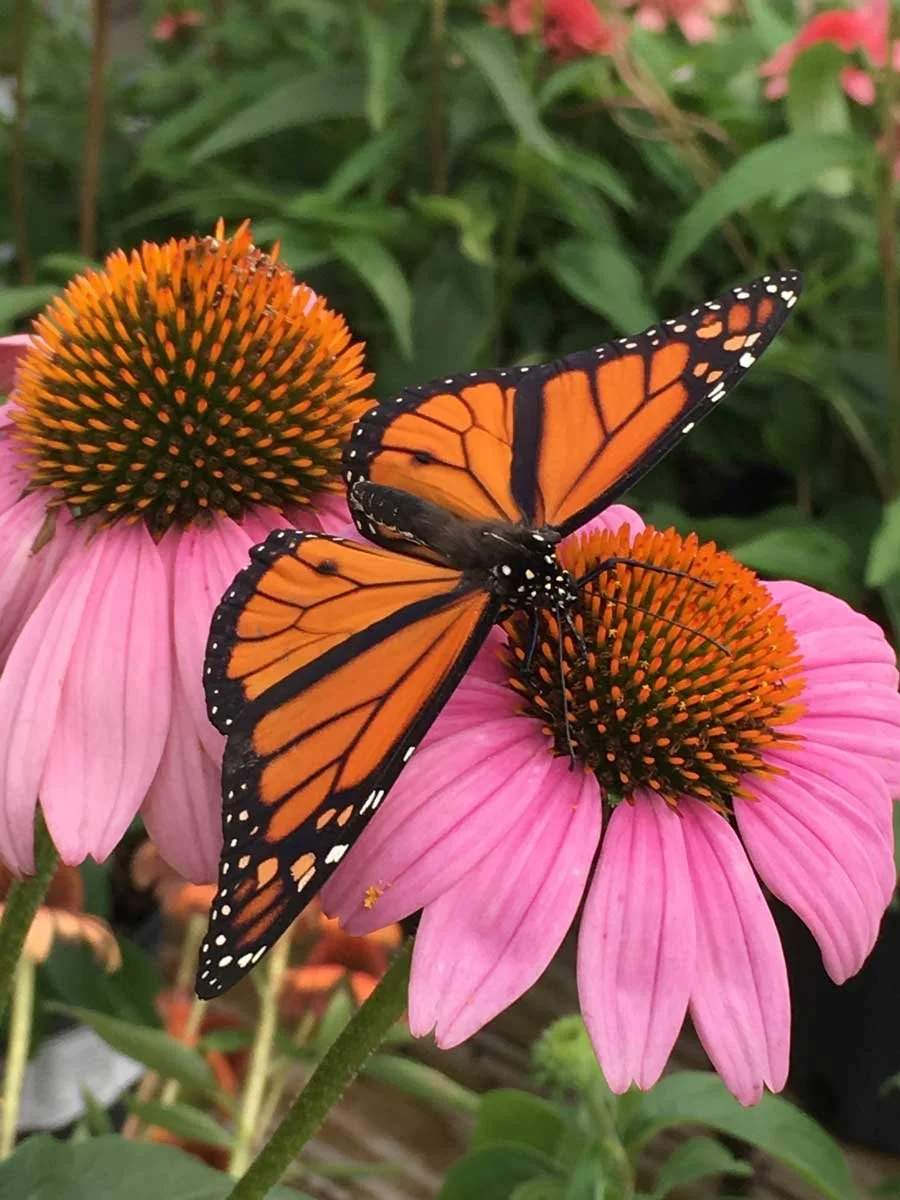"Not on our watch" Bee City USA - AVL Responds to Monarch Threat
Male monarch. Photo by Phyllis Stiles
This summer, the International Union for Conservation of Nature classified the migratory monarch butterfly as “Endangered." This news was tough to hear, but our Bee City USA - Asheville Leadership Committee didn’t get discouraged. They got to work.
The most important way we can protect the native pollinators that run our food ecosystem is to plant more native pollinator habitat.
That's why we put so much energy and effort into planting native pollinator habitats on public land, and certifying ones in backyard gardens and patio pots throughout Asheville.
Want to help us sustain our native monarchs?
Donate to support this vital work.
Giving the gift of milkweed....
When they heard the monarch news, our Bee City USA - Asheville Leadership Committee moved into action, fast-tracking plans to expand our current native pollinator habitat and plant new habitats this fall and in the coming spring.
Then, they got to take advantage of some fantastic timing…
Monarch caterpillar on milkweed. Photo by Phyllis Stiles
This summer, our dear friend Tim Wilkins coordinated the donation of 5,000 swamp milkweed plants grown and given by Costa Farms to pollinator guardians and groups throughout WNC.
Asheville Greenworks received 2,000 of the milkweed plants, which are the only plant where monarchs will lay their eggs.
GreenWorks installed 500 plants at our existing pollinator habitat on the Hominy Creek Greenway. and made about 600 plants available to the more than 140 gardeners who have certified pollinator habitats at their homes through GreenWorks.
With the rest of the plants, our Bee City - AVL Leadership team got creative to add monarch habitats in strategic places.
Here’s what we did with this incredible gift:
Planted a butterfly corridor on South French Broad Avenue
(See Linda’s story below)Created or expanded native pollinator habitat at three area elementary schools.
Started a native pollinator habitat at Mission Children’s Medical.
Expanded existing pollinator habitats at the Wilma Dykeman Greenway, Beaver Lake Park, and Beaver Lake Bird Sanctuary.
Helped restore riparian habitat at Todd Park Island on the New River.
Installed new pollinator habitat at Rhododendron Creek.
But it was more than just plants…
With butterflies, more is more....
“A lot of people in our neighborhood had already seen the very iconic yellow GreenWorks Certified Pollinator Habitat signs in our neighborhood and throughout Asheville, so they knew that native pollinator habitat was important,” said Linda Tsan, a Bee City "Pollenteer" and resident of South French Broad Avenue.
However, news of the monarch's endangered status made planting pollinator habitat a top priority. “It really rallied everyone with a sense of urgency to create a butterfly corridor," she said.
Putting native plants into every front garden bed and patio pot possible is vital, but to do the most good possible, we need to connect these individual oases into corridors.
GreenWorks is working to create or certify native pollinator corridors throughout Asheville to give our native pollinators the best possible chance to thrive. Join us by giving a gift to help us reach this goal.
Linda is amazing ....
When we let our Bee City - AVL community know that milkweed was available, Linda was one of the first people to stake a claim.
She worked with 18 of her neighbors to coordinate the planting of a butterfly corridor along South French Broad Avenue.
“Some folks added the milkweed to existing gardens and for others, the milkweed are the first thing they’ve planted," she said.
Linda added that this initial donation has inspired some neighbors to share or swap plants from their own gardens, adding, “We hope to add more and more plants every year.”
“I'm really excited to get more people involved with this, especially if we can get more donated plants,” Linda said, adding that she has been trying to find ways to make acquiring native pollinator plants accessible, so that socio-economic status doesn’t determine who can participate in expanding the corridor.
“Everyone deserves to walk out their door and see butterflies and beautiful flowers, and feel like they live in a beautiful place,” Linda said.
Investing in a native pollinator plant bank...
We share Linda’s excitement..and her goal to plant even more pollinator habitat wherever we can.
In fact, we’re gearing up to launch a pollinator plant “bank” at our Sand Hill Tree Nursery and Orchard this fall. Our goal is to create a storehouse where we can collect and care for donated plants, overwinter those donations — and then plant even more native pollinator gardens on public land, and support community plantings like the one on South French Broad Avenue.
To get there, we need your help.
Your gift today will allow us to create a dedicated hoop house for native pollinator plants and purchase soil and potting supplies.
When you support this vital work, you'll allow us to add huge capacity for the public pollinator plantings we have on deck for this fall and next spring.
Will you give a gift to get our pollinator plant “bank” up and running, so we can plant even more monarch-sustaining native pollinator habitat and expand the habitat we already have?



